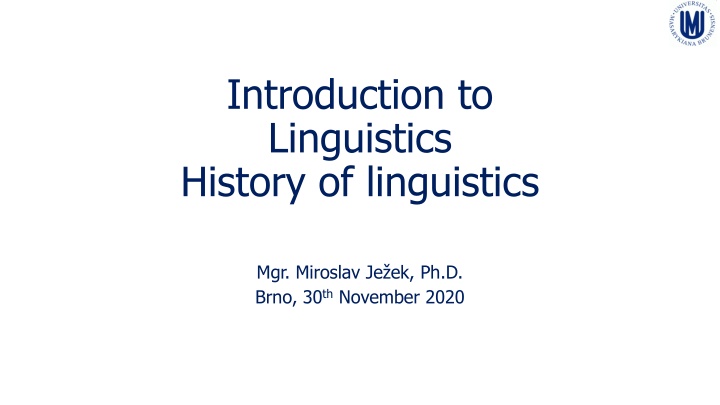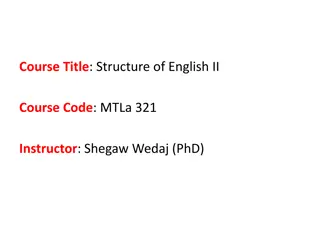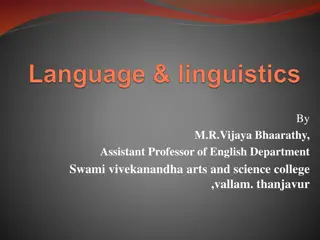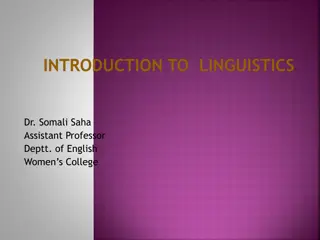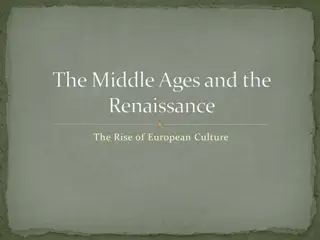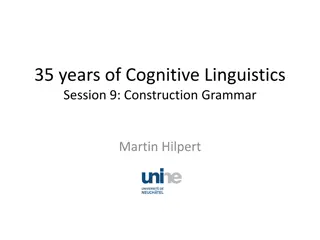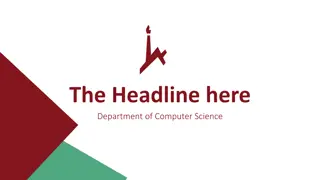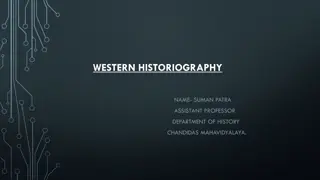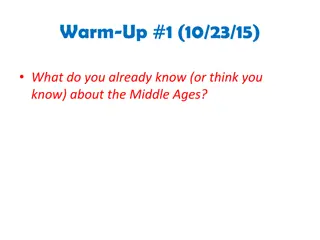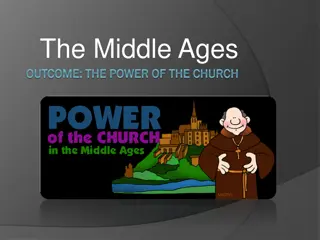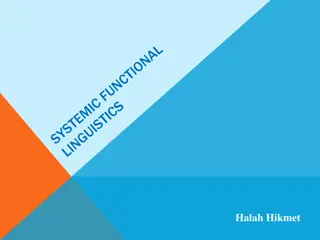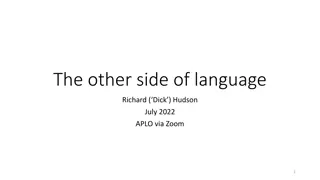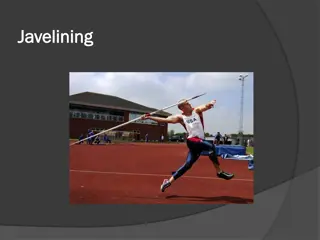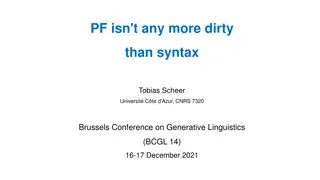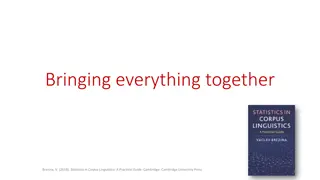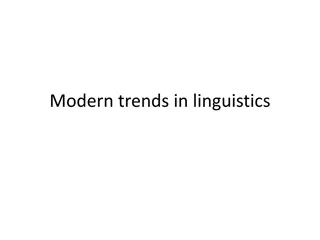Evolution of Linguistics: From Ancient Times to the Middle Ages
Linguistics has a rich history spanning from ancient India with the Vedas and Panini's grammar to Greece with Plato and Aristotle, and through the Middle Ages with the influence of Christianity on languages like Latin. The development of grammar, syntax, and the preservation of literary works shaped the study of language over centuries.
Download Presentation

Please find below an Image/Link to download the presentation.
The content on the website is provided AS IS for your information and personal use only. It may not be sold, licensed, or shared on other websites without obtaining consent from the author.If you encounter any issues during the download, it is possible that the publisher has removed the file from their server.
You are allowed to download the files provided on this website for personal or commercial use, subject to the condition that they are used lawfully. All files are the property of their respective owners.
The content on the website is provided AS IS for your information and personal use only. It may not be sold, licensed, or shared on other websites without obtaining consent from the author.
E N D
Presentation Transcript
Introduction to Linguistics History of linguistics Mgr. Miroslav Je ek, Ph.D. Brno, 30thNovember 2020
Contents ancient times the Middle Ages Renaissance and humanism discovery of Sanskrit comparative philology the Neogrammarians F. de Saussure and structuralist schools generativism interdisciplinary linguistics
India 1600-900 BC: the Vedas (religious texts in Sanskrit) About 500 BC: Sanskrit replaced by other languages->need to preserve it (describe its phonology, grammar and vocabulary) Panini (5-4thC BC): the first grammar of a language surviving till the present day (but 68 other grammarians are mentioned by him) its discovery at the end of the 18thC sparked comparative (historical) linguistics
Greece the Sophists (5thC BC): rhetoric-the art of speech, synonymy/antonymy Plato: etymology, the relationship between the form and meaning Aristotle: vowels/semivowels/consonants, no difference between written and spoken language (letter refers to sounds as well), form/meaning relationship purely conventional From the 3rdC: desire to preserve archaic literary masterpieces (Homer s the Iliad and the Odyssey) Aristarchus of Samothrace, Appolonius Dyscolus (vocabulary, syntax) Dionysios Thrax (170-90 BC): Techn grammatik , word categories, inflectional and conjugational categories
Rome Marcus Terentius Varro (116-27 BC): etymology, morphology, syntax, perfective and imperfective aspect of verbs Marcus Fabius Quintilianus (35-95 AD): rhetoric Aelius Donatus (4thC AD) and Priscianus (5th-6thC AD): Latin grammar books (e.g. Institutiones grammaticae) largely influenced by the Greeks (sometimes the terminology applied too mechanically) of great importance for the following eras (Middle Ages/Early Modern period, cf. 18thand 19thC prescriptivists: double negation, spelling (doubt), meaning (aggravate).
Middle Ages profound influence of Christianity upon formerly pagan nations and their languages translations of the Holy Script (or parts thereof) into other languages (most notably Ulfilas into Gothic and St Jerome into Latin (known as the Vulgate) in 4thC AD, later St Cyril and Methodius in 9thC) Gradually, Latin became by far the dominant language of scholarly disciplines because of its close link to the Catholic Church. Immense interest in Latin grammar led to questions of a more general linguistic character: especially the problem of the universals.
Problem of the universals The problem dates back to Plato and Aristotle. Also known as the dispute between nominalism and realism. Universals are qualities or relations found in two or more entities and the problem is essentially the nature of the relationship between the general and the specific. Nominalism: universals are verbal (mental) constructs and do not pre-exist entities (Roscellinus, William of Ockham). Realism: universals exist in reality (they exist beyond mere speech and thought) and are thus independent of the human mind (Thomas Aquinas, John Duns Scotus). Cf. 20thC positivism and the philosophy of language: the whole problem is merely that of language.
Renaissance Theology no longer the dominant discipline. Upsurge of interest in vernacular languages->need to analyse and describe their spelling + pronunciation, grammar and vocabulary (many dictionaries). Overseas exploration and discoveries unearthed more exotic languages (e.g. the Aztecs, the Incas, Asian languages). Interest in living languages propelled by the invention of printing.
17thcentury Carried on with the impetus from the Renaissance period. Two main philosophical methods: Empiricism: only reliable method is experience -> inductive reasoning (arguing from specific to general); Francis Bacon, John Locke, David Hume Rationalism: only reliable method is reason -> deductive reasoning (arguing from general to specific); Rene Descartes, Baruch Spinoza, Gottfried Leibniz Descartes influence: philosophical grammars, e.g. Port-Royal Grammar (1660), grammar is nothing but mental processes which are universal, hence grammar is universal (and not language- specific). P-R Grammar later influenced de Saussure and, above all, Noam Chomsky (generativism).
18thcentury More descriptions of exotic languages. First studies of what would later be labelled comparative philology (comparing related languages) Predominantly, linguists tried to answer the question of the origin of language. As in the previous centuries, most of them argued the first language was Hebrew. Cf. Leibniz (1710)-the first language must be much older than any known language. Condillac (1746)- there is no link between linguistic signs and our mental processes -> Saussure s arbitrariness of linguistic signs. Emergence of a great number of orthoepists and orthographists. The discovery of Sanskrit, William Jones, 1786, Calcutta.
The discovery of Sanskrit Jones demonstrated the historical kinship of Sanskrit with Latin, Greek, and the Germanic languages. Sanskrit became the dominant topic (plentiful grammars), its study became an academic obsession . Study of Sanskrit at the turn of the 19thC still far from linguistic, though: hunt for the first language (Ursprache) and the superiority of some languages compared to others.
Comparative (historical) philology Founding fathers: Rasmus Rask (1787-1832) Danish; studied old Scandivanian languages, later Slavonic and Oriental one; grammar (esp. morphology and phonology) more reliable than lexis. Franz Bopp (1791-1867) German; tried to find the first language but unsuccessful; language development=decadence; studied and compared conjugation in Sanskrit, Greek, Persian, and German. Jacob Grimm (1785-1863) German; studied Germanic languages only; sound laws, especially the so-called Grimm s law.
Grimms law (1822) Also called the First Germanic Sound Shift The first discovery of a systematic sound shift -> historical phonology. Three parts (phases) of a chain shift: 1/ IE voiceless stops /p, t, k, kw/ -> voiceless fricatives /f, , h, hw/ Lat pes -> Eng foot, Lat tertius -> Eng three, Lat canis -> Eng hound; Lat quod - > Old Eng hwat; 2/ IE voiced stops /b, d, g, gw/ -> voiceless stops /p, t, k, kw/ Serbian jabuka -> Eng apple, Lat decem -> Eng ten, Lat gelu -> Eng cold, Lithuanina ghywas -> Eng quick; 3/ IE aspirated voiced stops /bh, dh, gh/ -> unaspirated ones /b, d, g/ Sanskrit bhrathar -> Eng brother, Sanskrit madhu -> Eng mead, Sanskrit stighnoti -> Old Eng stigan (ModE ascend, climb).
Other 19thC philologists- Wilhelm von Humboldt Wilhelm von Humboldt (1767-1835) In many ways was not part of the main trend of comparative philology (unlike his contemporaries, he was mainly interested in living languages). Inspired by nationalist romanticism, his main focus was on the relationship between language and thinking -> the better the language, the better the nation. Each language creates the individual s worldview through its lexical and grammatical categories and its conceptual organisation. Innere Sprachform (inner speech form)- latent psychic processes that are manifested by the outer form (i.e. the structure of the language) Cf. the Sapir-Whorf hypothesis (the 1920 s)
Other 19thC philologists- August Schleicher August Schleicher (1821-1868) professor at Prague University in the 1850 s (apart from the usual languages, he got a lot of evidence for his theories from the Lithuanian language). originally a botanist hugely influenced by darwinism -> saw language as a living organism and linguistics was one of natural sciences. Stages in the life of a language: isolating -> agglutinative -> inflectional, then decadence and language death. Stammbaumtheorie: a genealogical tree for languages (the trunk being the hypothetical Proto-Indo-European language).
The Neogrammarians 1875 Karl Verner (Danish) defined the so-called Verner s law: it described a historical sound shift that explained the apparent exceptions to the Grimm s law. According to Grimm s law: IE /p, t, k/ -> voiceless /f, , h/, but: only in stressed syllables. In unstressed ones, as Verner demonstrated, they turned into voiced fricatives / , , /, which later turned into /b, d, g/. Example: IE *septm -> German sieben (not siefen). This success sparked a number of new studies and a journal, published by Karl Brugmann and Hermann Osthoff, in which the new generation of linguists called themselves the Junggrammatiker (the Neogrammarians).
The Neogrammarian hypothesis ausnahmlose Lautgesetze (laws that admit no exceptions) A diachronic sound change affects simultaneously all words in which its environment is met, without exception. Historical development of a language and the description of the sound changes is the only scientific method in linguistics (any interest in the current languages pure amateurism). Criticism: language is a social fact (not natural), the theory of lexical diffusion shows that some words are affected first, others follow (or not).
Towards the Copernican turn in linguistics Dialectology (dialect geography) Georg Wenker (Germany) and Jules Gillieron (France) from the 1870 s- hitherto rejected dialects ( degenerate varieties of the standard languages) in the centre of attention because they resist foreign influence. initially supported by the neogrammarians (great interest in sound changes and the aim was to track ancient forms as back as possible). later refuted because it disproved their hypothesis (many, many exceptions ). from universal sound laws (changes) to individual word histories.
Towards the Copernican turn in linguistics Aesthetic idealism Benedetto Croce (Italy), Karl Vossler (Germany) Influenced by W. von Humboldt from 1900 Language as a means of individualistic intuitive expression => linguistics part of aesthetics and must be studied in close relation to culture, religion, art, history, etc. No meaning but in the individual s mind and his/her imagination. Language mirrors the individual s mind, his/her aesthetic ideal. Linguistic change is thus only triggered by the individual.
Towards the Copernican turn in linguistics William D. Whitney American linguist (1827-94) 1875: The Life and Growth of Language His ideas known by Saussure, e.g. the theory of a linguistic sign and its arbitrariness
Towards the Copernican turn in linguistics Kazan School of Linguistics Founded in the 1870 s Jan Baudouin de Courtenay (d. 1929), Mikolaj Kruszewski (d. 1887) In many ways the school anticipates the 20thC turn towards synchronic linguistics (language of a community v. language of an individual; language development v. current state; division of physiophonetics and psychophonetics). The School only lasted for about 10 years => not enough time to properly analyse and discuss the notions; unknown for many years before de Saussure brought their teaching to light. De Courtenay later worked in St Petersburg, e.g. came up with a new definition of phoneme (very close to that of Trubetzkoy).
The Copernican turn in linguistics- structuralism Ferdinand de Saussure (1857-1913) Founder of structuralism in Geneva. Studied in Leipzig (trained in comparative philology), later worked in Paris and Geneva. 1907-11 lectures later (1916) posthumously published by two of his students => Cours de linguistique g n rale, Course in General Linguistics How much of it is actually Saussure? He tried to strip away all that is accidental to language (history, psychology, society, etc.) speakers are perfectly capable of using their language even if they know nothing about its history. Linguistics is thus a fully autonomous discipline.
Structuralism- key concepts Synchronic v. diachronic approach to linguistic studies Langue v. parole Language as a system- units defined by their function Syntagmatic v. paradigmatic analysis of the language system Linguistics part of semiology->revolutionary claim that linguistics belongs to the realm of social studies Linguistic sign- signifiant (signifier) v. signifi (signified) arbitrary relationship between the two
Synchronic approach It challenged the up-until-then dominant diachronic approach, i.e. synchronic is as scientific as diachronic (historical). It demonstrates how all the forms and meanings are interrelated at a particular point in time in a particular language-system (Lyons 1981: 188). Linguistics is analytically comparative (rather than historically comparative like before) => makes it possible to compare also languages from different families (e.g. Czech and English). The main difference, though, lies in the structural (and not atomistic) approach. structure=-system, paradigmatic (vertical (i.e. contrastive) variants of a single unit) and syntagmatic relationship between units (horizontal (i.e. combinatorial) connection of at least two units based on their mutual compatibility).
Langue v. parole Language-system v. language behaviour. Parole is the external raw manifestation of the linguistic data in their actual communicative context , while langue denotes the basic underlying system of structured oppositions which makes it possible to produce and understand such contextualised instances of parole (Mair 2015: 209). Chess analogy. Linguists should only focus on langue. Language-systems are unique and there are thus no universal properties of language (apart from the very general semiotic ones like arbitrariness, productivity, discontinuity), cf. Chomsky s firm rejection of this.
Linguistic sign A conventional pairing of sound (the signifier, in French signifiant) and meaning (which is signified, in French signifi ). Like other conventional form-meaning pairs (e.g. road-signs), the relationship between the two components is purely abritrary.
Other structuralist schools Prague Linguistic Circle Founded in 1926 Vil m Mathesius, Nikolay Trubetskoy, Roman Jakobson, Bohumil Trnka, Bohuslav Havr nek, Jan Muka ovsk , Vladim r Skali ka, Josef Vachek, Jan Firbas Functional-structuralist school Discussed in great detail in lecture given by prof. Kudrn ov (7/12)
Other structuralist schools Copenhagen School- glossematics Founded in 1934 by Viggo Brondal and Luis Hjelmslev. Closely linked with language philosophy, especially with logic. Language study calls for unique methods completely unrelated to other disciplines (physiological, sociological, functional, etc.) => highly abstract (formalist or mathematical) approach called glossematics (glossa=language in Greek), an algebra of language in Hjelmslevs words. Redefined and renamed many structuralist dichotomies (e.g. phoneme is ceneme, from Greek keinos=empty)
Other structuralist schools American school- descriptivism Founded in 1924 (Linguistic Society of America), Language journal. Franz Boas (d. 1942), Edward Sapir (d. 1939) and L. Bloomfield (d. 1949) Unique in its earlier focus on linguistic anthropology and etnography (languages of native Americans) As in the teachings of the Copenhagen school, form is given prominence over meaning (mathematical methods, esp. later in Bloomfield). Special interest in phonology and morphology Sapir s Language (1921): language as a cultural phenomenon that is acquired (not innately given) Sapir-Whorf hypothesis: mutual determination of language, culture and thought -> the structure of the language that we speak determines what we can think and express in our culture (originally von Humboldt s idea, cf. Wittgenstein s Tractatus (5.6) The limits of my language mean the limits of my world ).
Other structuralist schools American school- descriptivism Bloomfield s Language (1933): influenced by behaviourism (S -> r s -> R, S=stimulus, R=reaction, linguistics is only interested in the r s part) Descriptivism dominated American linguistics for a number of decades, finished in the late 1950s with the arrival of generativism (Noam Chomsky).
Generativism Started in the 1950 s by Noam Chomsky (b. 1928) Grammatical structures have nothing to do with function (i.e. communicative needs) If children can produce and understand previously never heard-of utterances, then language acquisition cannot develop in response to environmental stimuli -> this creativity (i.e. the capacity for unlimited creativity through the application of a limited number of productive (generative) rules on an equally limited number of linguistic forms; Mair 2015: 212) is then a rule- governed activity. These rules have the formal properties determined by the human mind (linguistics is a mentalist discipline) and are judged by the criterion of well-formedness. Are utterances grammatical or not? competence v. performance (roughly the same as langue v. parole)
Generativism Unlike structuralism (linguistic diversity), generativism is deeply convinced there are linguistic universals exactly what linguistics should deal with. Language-faculty in generativism is innate and species-specific -> humans are born with a Universal Grammar, which is latently present and activated in such a way as to produce a particular language. UG is a highly complex set of rules based on mathematics and philosophical logic. Criticism: grammatical systems are not mathematical algorithms (they are not so neat and well-defined) as there are many hazy points that are based on one s communicative needs as well as the contextual setting. More about generativism in dr. Pelclov s lecture (23/11)
British contextualism Started by J R Firth (d. 1960) and then M A K Halliday (d. 2018) Does not divide langue and parole so sharply and calls for an approach that reflects both -> language must be studied in both its social and communicative contexts Lexis and grammar are not sharply divided either, it is a continuum. Great impact on lexicography esp. in the non-native world (ELT).
Interdisciplinary linguistics Sociolinguistics (since the 1960 s) William Labov (b. 1927) Quantitative (more or less rather than either or) methods to study language variation and change Aim is to document statistically significant correlations between independent social variables (such as gender, age, social class, regional background, etc.) Key notion: the linguistic variable (e.g. the glottal stop, /h/-dropping). Move from rural to urban dialectology
Interdisciplinary linguistics Corpus linguistics Enabled by rapid development of technology and its data storage capacity Real-world samples of speech/texts stored in corpora are studied and analysed. Advantage: no influence from the observer, all data gathered in a completely natural context
Interdisciplinary linguistics Psycholinguistics (since 1951) American psychologists and linguists set up to address the issue of foreign language acquisition. Initially a mixture of American descriptivism plus behaviourism plus theory of information, later challenged by Chomsky s generativism (innate language capacity). Today, the focus is on cognitive processes (how information is perceived, analysed, stored in memory, then activated and reshaped).
Interdisciplinary linguistics Neurolinguistics (since the 1950s) Studies neural mechanisms in the human brain that affect how language is acquired, produced and understood. Special focus on aphasias (i.e. inability to produce and understand language due to damage to certain brain regions) Speech centres
Interdisciplinary linguistics Philosophy of language (from time immemorial) Like in any other interdisciplinary field that contains philosophy, philosophy of language aims to generalise the linguistic findings about language and answer the very basic questions of its nature. Special focus on the relationships between language and thought and language and extralinguistic reality. Bertrand Russell: logical atomism: world consists of unrelated facts, any relationship between such atomic facts is due to the fact that humans interpret facts by means of language.
Interdisciplinary linguistics Philosophy of language (from time immemorial) Ludwig Wittgenstein: Tractatus Logico-philosophicus (1921): 4.002: Language disguises the thought; so that from the external form of the clothes one cannot infer the form of the thought they clothe, because the external form of the clothes is constructed with quite another object than to let the form of the body be recognized. The tacit conventions on which everyday language depends are enormously complicated. 4.0031: All philosophy is a critique of language . 5.6: The limits of my language mean the limits of my world. 7: What we cannot speak about we must pass over in silence.
References Lyons, John. 1981. Language and Linguistics. Cambridge University Press: Cambridge. Mair, Christian. 2015. English Linguistics. Narr Francke Attempto: Tubingen.
